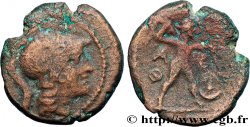正面
正面的文字 + CAROLVS. V - (8) - IMPERATOR.
正面的说明书 Buste lauré et cuirassé de Charles Quint à gauche, vu de trois quarts en avant.
正面的翻译 (Charles Quint, empereur des romains).
背面
背面的文字 + MONETA. CIV. IMP. BISONT.
背面的说明书 Écu aux armes de Besançon ; au-dessus 1639.
背面的翻译 (Monnaie de la cité impériale de Besançon).
历史细节
TOWN OF BESANCON - COINAGE STRUCK IN THE NAME OF CHARLES V
(1555-1676)
Charles V said Charles Quint was born in Ghent on February 25, 1500 from the union of the Archduke Philippe le Beau and Jeanne la Folle. On the paternal side he was the grandson of Maximilian I of Habsburg and on the maternal side, grandson of the Catholic Kings, Ferdinand and Isabella. He became ruler of the Netherlands when his father died in 1506, when he was only 6 years old. A period of regency was exercised by his aunt Margaret of Austria until his emancipation before the States General on January 5, 1515. On January 23, 1516, his maternal grandfather died and he acceded to the throne of Spain under the name of Charles I. After the death of Maximilian I, Charles was elected German Emperor on June 28, 1519, under the name of Charles V. This election was at the origin of a long conflict which opposed him to the King of France François I. Charles Quint abdicated on October 25, 1555 from his possessions in the Netherlands and then on January 16, 1556 from his Spanish possessions. He died on September 21, 1558 in the monastery of San Jeromino de Yuste.








 对产品描述纠错
对产品描述纠错 打印
打印 分享我的选择
分享我的选择 提问
提问 Consign / sell
Consign / sell










